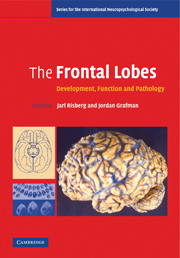Book contents
- Frontmatter
- Contents
- Contributors
- From the series editor
- Introduction
- 1 Evolutionary aspects on the frontal lobes
- 2 Organization of the principal pathways of prefrontal lateral, medial, and orbitofrontal cortices in primates and implications for their collaborative interaction in executive functions
- 3 Human prefrontal cortex: processes and representations
- 4 A microcircuit model of prefrontal functions: ying and yang of reverberatory neurodynamics in cognition
- 5 Prefrontal cortex: typical and atypical development
- 6 Case studies of focal prefrontal lesions in man
- 7 Left prefrontal function and semantic organization during encoding and retrieval in healthy and psychiatric populations
- 8 Clinical symptoms and neuropathology in organic dementing disorders affecting the frontal lobes
- Index
- Plate section
- References
1 - Evolutionary aspects on the frontal lobes
Published online by Cambridge University Press: 11 September 2009
- Frontmatter
- Contents
- Contributors
- From the series editor
- Introduction
- 1 Evolutionary aspects on the frontal lobes
- 2 Organization of the principal pathways of prefrontal lateral, medial, and orbitofrontal cortices in primates and implications for their collaborative interaction in executive functions
- 3 Human prefrontal cortex: processes and representations
- 4 A microcircuit model of prefrontal functions: ying and yang of reverberatory neurodynamics in cognition
- 5 Prefrontal cortex: typical and atypical development
- 6 Case studies of focal prefrontal lesions in man
- 7 Left prefrontal function and semantic organization during encoding and retrieval in healthy and psychiatric populations
- 8 Clinical symptoms and neuropathology in organic dementing disorders affecting the frontal lobes
- Index
- Plate section
- References
Summary
Introduction
The purpose of this chapter is to introduce you to the fascinating story about the evolution of the human brain and especially of its frontal lobes. The story begins in south east Africa some six million years ago and ends with the recent development of modern behavior and mental abilities like symbolic language and creative thinking. Some disadvantages linked to the dangers and demands of a large size brain will be dealt with. A discussion of the anatomical differences between the human brain and that of our close relatives, the African great apes, will follow. Evolutionary advantages linked to the big brain and its advanced frontal lobes will be described, with special focus on the evolution of language and abstract thinking. Our still very limited knowledge about what changes of the human genome, that made it possible to develop modern behavior, is then summarized. The chapter will end by discussing two very old and specifically human mental disturbances, schizophrenia and attention deficit hyperactivity disorder, from an evolutionary perspective.
Early history of human evolution and “the creative explosion”
The tremendous success of humanity, regarding population growth and ability to occupy practically all parts of the earth, is not due to any great bodily advantages of our species. Our main advantage is the possession of a brain that makes it possible for us to outsmart and control most of our competitors and enemies on the planet Earth and to change and use the environment to our (short-term) advantage.
- Type
- Chapter
- Information
- The Frontal LobesDevelopment, Function and Pathology, pp. 1 - 20Publisher: Cambridge University PressPrint publication year: 2006
References
- 3
- Cited by

